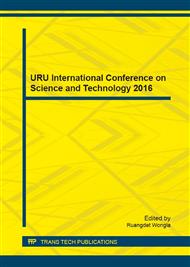[1]
A.M. Saeedan, S. Kh. Bamoteref, M.A. Algahri, RP-HPLC Determination of Benzoic Acid in Samples of Children Food Distributed in Aden-Yemen, Int. Res. J. Pure. App. Chem. 4(5) (2014) 507-519.
DOI: 10.9734/irjpac/2014/8720
Google Scholar
[2]
R. Wood, L. Foster, A. Damant, P. Key, Analytical methods for food additives, Woodhead, Cambridte, (2004).
Google Scholar
[3]
J. Burana-osot, L. Arunsingkharat, M. Naksuk, S. Naungnamjai, T. Saetun, Validation of a HPLC Method for the Determination of Benzoic Acid and Sorbic Acid in Noodles, Chiang Mai J. Sci. 41(2) (2014) 370-382.
Google Scholar
[4]
WHO, Concise International Chemical Assessment Document; 26: Benzoic acid and sodium benzoate, World Health Organization, Geneva, 2000. Information on http: /www. who. int/ipcs/ publications/cicad/cicad26_rev_1. pdf.
Google Scholar
[5]
Z. -H. Wang, J. -F. Xia, F. -Y. Zhao, Q. Han, X. -M. Guo, H. Wang, M. -Y. Ding, Determination of benzoic acid in milk by solid-phase extraction and ion chromatography with conductivity detection, Chi. Chem. Lett. 24 (2013) 243-245.
DOI: 10.1016/j.cclet.2013.01.048
Google Scholar
[6]
X. -J. Ding, N. Xie, S. Zhao, Y. -C. Wu, J. Li, Z. Wang, Simultaneous determination of ten preservatives in ten kinds of foods by micellarelectrokinetic chromatography, Food Chem. 181 (2015) 207-214.
DOI: 10.1016/j.foodchem.2015.02.060
Google Scholar
[7]
CAC, Recommended methods of analysis and sampling (Codex STAN 234-1999), Codex Alimentarius Commission, Rome, 1999. Information on http: /www. fao. org/fao-who-codexalimentarius/standards/list-standards/en.
DOI: 10.1016/b978-0-12-822521-9.00135-0
Google Scholar
[8]
F. Chemat, V. Tomao, M. Virot, Ultrasound-Assisted Extraction in Food Analysis, in: S. Ötleş (Eds. ), Handbook of food analysis instruments, CRC, Florida, 2008, pp.87-103.
DOI: 10.1201/9781420045673.ch5
Google Scholar
[9]
T. Prommajak, S. Surawang, N. Rattanapanone, Ultrasonic-assisted extraction of phenolic and antioxidative compounds from lizard tail (Houttuynia cordata Thunb. ), Songklanakarin J. Sci. Technol. 36(1) (2014) 65-72.
Google Scholar
[10]
M.I.S. Melecchi, V.F. Péres, C. Dariva, C.A. Zini, F.C. Abad, M.M. Martinez, E.B. Caramão, Optimization of the sonication extraction method of Hibiscus tiliaceus L. flowers, Ultrason. Sonochem. 13 (2006) 242-250.
DOI: 10.1016/j.ultsonch.2005.02.003
Google Scholar


